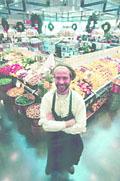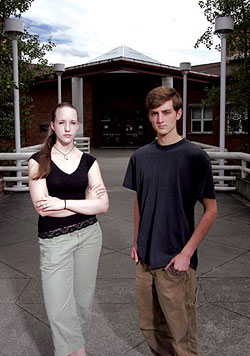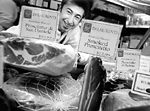The next time you sit down to a restaurant meal graced with chanterelles or huckleberry sauce, savor a salad garnished with sea beans, or slice into a slab of lobster mushroom, remember this name: Anna Hoffer.
Seattle-area chefs know Anna and her sister Veronica well. They are two of the region’s top foragers, and they turn up some of the best and most unusual items you wouldn’t think of eating until you see them on a plate. They sell to some of the area’s best eateries; Labu(breve)znik’s, Place Pigalle, Rover’s, the Dahlia Lounge, Cafe Flora, Marco’s, and Lampreia, among others.
I met Anna one early fall afternoon along the shores of Willapa Bay. She’s an aging woodland sprite—her hands are worn and tough, with hardened fingernails tapered to points. Her wrists are blue, and her hair—blond, silver, and gathered on her head in a wispy bun—frames a face lined from years of outdoor life.
As you can imagine, when Anna takes a walk in the woods, it’s hardly a quiet, ruminative stroll. It’s a scavenger hunt. Her eyes scan the ground, looking for the musty swelling that betrays a chanterelle about to surface. Her glance runs over the scrubby bushes and forest floor, searching for berries or assessing a reddish fungal shelf on the trunk of a fir tree.
“I want to get ’em all,” she declares. “That’s my game.” She calls it a game, but when Anna describes her heritage, you understand the fanaticism she brings to her work.
“We were a family of, well, scroungers, that’s the only way I can think of to say it, way back to the 1700s in the Austrian Empire,” she explains. “To survive in the Carpathian Mountains, you had to know how to find things. Hazelnuts, mushrooms, all kinds of berries, deer, elk, anything you could get away with. See, my family had nothing of their own; they were peasants living on royal land. The only thing they could grow was potatoes, so they had to scrounge the rest.”
Anna spies a salal bush loaded with dark blue berries. “These are great,” she proclaims, bending down to slide a few berries off the branch, into her hand, and then to her mouth. “I can probably sell these to Scott [Carsberg] at Lampreia.” I’d thought of salal as just a ground cover; in fact this hedge is someone’s decorative garden border. But the berries have a deep, sun-tempered, rich flavor and obviously belong next to game or salmon.
Anna and Veronica learned to be keen-eyed at the knees of their mother. The depression-wracked and war-ravaged hills of central Europe were their classroom. “She taught us about the woods. We’d help her search for mushrooms,” Anna says. “During World War II our whole village was literally just shoved around by the Germans. We had to forage for anything to eat. I remember that well—especially the winter of 1944. The biggest people died first; they needed the most food.”
In 1950, Anna and Veronica were shipped from postwar refugee camps to Raymond, in southwestern Washington, to live with an uncle. She Americanized quickly, and even became a cheerleader in high school. But the hard-learned lessons in frugality and living off the land stuck. “We were used to living a life of necessity. We ate cheaper than anyone else and saved all our money. We picked blackberries for $10 a day.”
The forest and fields of Pacific County were fertile grounds for scrounging, and Anna stumbled onto her life’s work in 1964, when she and Veronica were out hunting. “We discovered some chanterelles in the woods. We didn’t know they grew here; we’d only seen them in Austria. But we built a fire and roasted them, just like we did in Europe. They were great.”
This was the Northwest well before the good food explosion of the last two decades, and no local restaurant served chanterelles. But the Space Needle had just hired a German chef. “I knew that Germans loved chanterelles,” she recalled, “so I took some to him. He was really excited, and said he’d buy all we could find.” Anna saw there was a market in Seattle for her talents, and since then has cultivated a number of loyal chefs.
“She showed up at the back door when we first opened,” Thierry Rautureau, owner of Rover’s, said. “I was a little surprised, because that’s more common in Europe. Someone will bring their apples, or beans, or wild mushrooms to a restaurant. It’s unpredictable dealing with foragers, and that can be a real pain in the rear,” Rautureau added. “But the advantage is that you just can’t get that quality anywhere else. We’ll take anything she’s got at any given time.”
The cullings can be quite unusual. Take salacornia, also called the sea bean. It looks a bit like young asparagus and has a fresh, crisp, slightly salty taste. It grows at the edge of the high water mark. Anna learned about salacornia from the Chinook tribe, who live on the Long Beach peninsula.
“The Indians taught the early settlers to use it. They called it ‘pickle weed.’ You have to soak them in fresh water ’cause they’re very salty. But if you just steam them a little bit, they’re delicious.” She now sells sea beans to Rover’s, Place Pigalle, and the Dahlia Lounge. “We blanch them in fresh water, and use them Asian-style with seared scallops,” says John Sundstrom, head chef at Dahlia Lounge.
Anna also pursues the native blackberry. While the Himalayan variety overruns vacant lots and produces those familiar large, tame-tasting berries, the native berries are rarer, more complex in taste, and fewer in seeds. The berries thrive on Weyerhaeuser’s logged-off lands around Willapa. “People love them,” Anna says. “Every year I advertise in The Seattle Times when they come in. I sold 200 gallons this year.” But a forager depends on access, and Weyerhaeuser and the state this fall gated off a lot of the roads, so Anna says she won’t get nearly as many next year.
In her search for other culinary delights, Anna scours the verdant hillsides. She finds chanterelles, boletes, honey mushrooms, sour dock (sorrel)—the basis of the wonderful soup called tschav—and fiddlehead ferns. She has peddled wild watercress to Rover’s. She’s picked evergreen huckleberries at Snoqualmie Pass and sold them to the Place Pigalle. She’s offered red huckleberries to the Palace Kitchen and beach huckleberries to Labu(breve)znik’s.
She also makes decorative wreaths and sells them. She arranges dried grasses and flowers for restaurant walls. She found a beautiful bay laurel tree in the little town of Bay Center and marketed the leaves to Filipino merchants at Pike Place Market. She sells to restaurants in Atlanta and New York City, and to buyers from Germany and Japan. She’s a one-woman dynamo, a cornucopia overflowing with the earth’s bounty but running on nature’s schedule.
“It’s all or nothing with Anna,” the Dahlia Lounge’s Sundstrom says. “Whenever she shows up, we try to buy everything we can, because we never really know when she’s coming back.” So treasure that wild mushroom or sprinkle of huckleberries, and praise foragers in general, and Anna and her fanatical leanings. “It’s kind of an addiction,” she reflects. “I push for the most. I want to beat everyone to the patch.”








